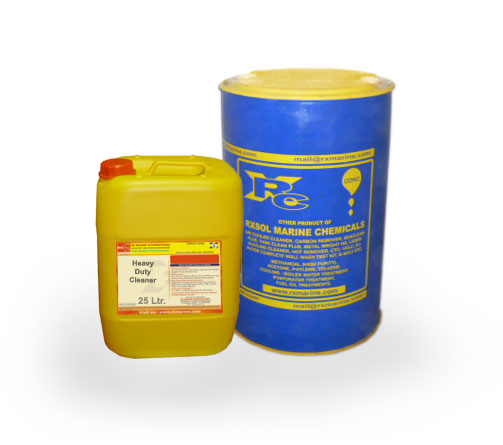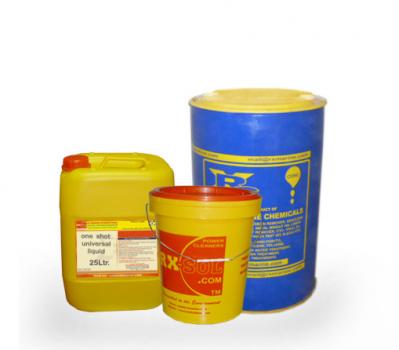One Shot Universal Liquid Treat
NF Multi Plus, RXSOL BWT LIQUID PLUS, Arboiler WT Care Treat 3 Boiler 2, Drew Ameroid, Boiler Water Treatment, BWT 104P, DM-511
CHARACTERISTIC :
- Convenient liquid treatment, which provides the basic alkalinity on which successful water treatment depends.
- Provides optimum conditions for hardness control to function.
- Neutralizes acid conditions.
- Will assist in keeping silica in suspension.
- Simple test to determine level of treatment.
- Can be used in boilers of all pressures.
- Can be used as a neutralizer after acid cleaning operations
- Suitable for use with all auxiliary boilers; waste heat units; economizers, package boilers, smoke and water tube boilers.
- Dispersant action suspends sludge and sediment particles for efficient blow down.
- Oxygen scavenging for optimum protection.
- Protects boiler, steam lines, condensate lines and feed water lines from corrosion.
- Fast action due to catalyst.
- Simple test to determine level of treatment.
A one-step and one SHOT treatment to control the formation of rust and scale in boilers. Contains alkaline compounds, scale and corrosion inhibitors, oxygen scavengers and sludge conditioners. which resulting in a scale and corrosion control by one shot operation.
Basic Boiler System Schematic
Below is a summary of problems associated with the common impurities in water and solutions to each problem.
List Of Problems Caused By Impurities In Water
|
Impurity (Chemical Formula) |
Problems |
Common Chemical Treatment Methods |
|
Alkalinity (HCO3-, CO32- and CaCO3) |
Carryover of feedwater into steam, produce CO2 in steam leading to formation of carbonic acid (acid attack) |
Neutralizing amines, filming amines, combination of both, and lime-soda. |
|
Hardness (calcium and magnesium salts, CaCO3) |
Primary source of scale in heat exchange equipment |
Lime softening, phosphate, chelates and polymers |
|
Iron (Fe3+ and Fe2+) |
Causes boiler and water line deposits |
Phosphate, chelates and polymers |
|
Oxygen (O2) |
Corrosion of water lines, boiler, return lines, heat exchanger equipments, etc. (oxygen attack) |
Oxygen scavengers, filming amines and deaeration |
|
pH |
Corrosion occurs when pH drops below 8.5 |
pH can be lowered by addition of acids and increased by addition of alkalies |
|
Hydrogen Sulfide (H2S) |
Corrosion |
Chlorination |
|
Silica (SiO2) |
Scale in boilers and cooling water systems |
Lime softening |
Boiler Water Treatment chemicals manufacturer and supplier in India UAE Oman Nairobi, Sudan Yemen. One Shot Universal Liquid Treat is most advanced Boiler Water treatment Chemicals supplier in Mumbai, Navi Mumbai MIDC, Kolkata, Chennai, Haldia, Ennore, Paradip, Kandla Mundra Gandhidham, Visakhapatnam, Gangavaram, Kakinda, And in GULF Fuajirah, Dubai, Sharjah, Ajman, Abudhabi, UAE, Ruwi Barka Ghala, Muscat Oman, Nairobi Kenya, Sudan, Yemen
Chemical feed should be continuous. Chemical pumping rates can create problems especially for neat feed set ups. Using on/off feed systems such as a recycle timer can create problems. Chemical feed pumps should be sized or product strengths should be adjusted to allow continuous feed.
Steam and carbon dioxide leave continuously, so setting up a neutralizing amine pump to feed intermittently can lead to wide variations in condensate pH control. If sampling is done from a condensate receiver, the tank volume may buffer the variations and the changes may not be noticed, but corrosion could be occurring to areas of the piping that see the rapidly changing pH.
If polymeric dispersants, phosphonates, phosphate, or chelants are fed intermittently into the feedwater using a recycle timer, and the amines are not fed continuously, a cycle of iron slugs returning in the condensate can be followed by slugs of high dispersancy cleaning of the iron from the deaerator and dragging it into the boiler.
Load changes can affect chemical concentrations when the chemical feed is base fed. Example: Steam production of one million lbs./day; 4% blowdown; 20% active boiler polymer product fed at 5 pounds per day. The calculated daily average polymer concentration would be 24 ppm. Assume peak plant production load is 60,000 lbs./hr., but during the overnight hours the load is only 5,000 lbs./hr. If the dispersant is being fed continuously over the 24 hours, during the 8- hour low load period, the boiler polymer concentration would have increased to over 200 ppm. Upon high fire when production resumes, carryover is very possible because of over concentrating the polymeric dispersant.
Chemical feed needs to be paced to steam production, especially where significant load changes occur.
Carbon dioxide can concentrate in steam and condensate making neutralizing amine treatment impractical. Carbon dioxide levels can be relatively low in steam exiting a boiler at only a few ppm, but if there are areas where it becomes “trapped” and can accumulate, concentrations can reach extremely high levels into the hundreds or even thousands of ppm.
CO2 is a non-condensable gas. It has a distribution ratio in the steam piping and condenses at points throughout the system. At the boiling point, the solubility of the gas in water is extremely low. The solubility of the CO2 is actually lower in the condensate than it is in the steam. For the CO2 to escape from the steam into the water it will accumulate in the steam space just above the water level until the partial pressure becomes high enough for the CO2 in the incoming steam to be able to exit into the condensate. This creates a steady state condition of CO2 coming in and exiting, but an area of severe localized corrosion occurs where the carbon dioxide concentration is high.
The highest CO2 concentration normally occurs just above the condensate water level. If there is an area where condensation is occurring and running down pipes or the sides of vessels, the CO2 concentration will be very high and the pH will be about 5.3 – 5.5 in that location creating high corrosion rates.
The solubility of CO2 increases dramatically as the condensate temperature falls below 212 °F. When there is an accumulation of CO2 in an area and the condensate temperature is relatively low, the amount of carbon dioxide going into solution will be extremely high. Where low-pressure steam is used that contains CO2 and the heat exchange process has relatively close temperature differentials between the steam and the condensate, there is potential for high uptake of the CO2 into the condensate and localized low pH.
Neutralizing amines are selected in an effort to condense in the right concentrations to carbon dioxide condensation levels throughout the steam system. Neutralizing amines cannot control corrosion where this localized accumulation of carbon dioxide occurs since the high CO2 overwhelms the demand for the amine. Even point source addition of amine may not be able to satisfy the demand.
Where the concentrating effect of CO2 occurs, methods of reducing the problem include eliminating or minimizing CO2 in the steam, venting off the CO2 in the localized area, eliminating condensate in the area, applying a filming amine or metal passivator, or using higher temperature steam and increasing condensate temperature to reduce the CO2 content in the condensate.
18 / 25 / 35 / 210 Ltr.
RX MARINE INTERNATIONAL is most popular chemicals source in INDIA, Keeping ready stock at 5 LOCATION which includes Mumbai, Kandla - Gandhidham, Vizag - Visakhapatnam, Ennore - Chennai, Kolkata more then 3000 types of chemicals. Please click here to get PRODUCT Categories details http://rxmarine.com/Products
Mail Us for any PRODUCT related information and purchase inquiry : rxmarinechemical@gmail.com ( This mail is for customer / Buyer only ) And if you wants to add your hand as a supplier, And if you have volume manufacturing capacity of chemicals, pl. drop your mail at rxmarinechemical@gmail.com ( This mail is for supplier only )































